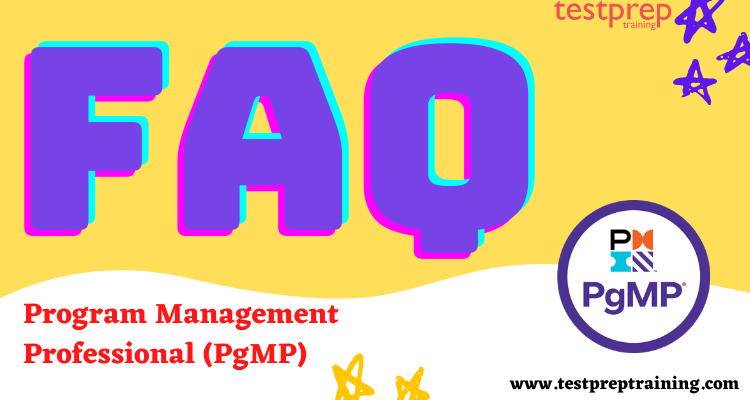Program Management Professional (PgMP)
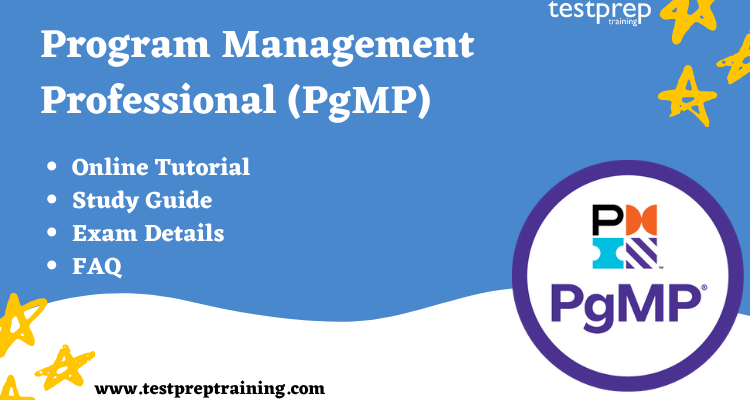
The Project Management Institute (PMI®) gives a professional credential for program managers, identified as the Program Management Professional (PgMP). The PgMP exam is a lively part of the activities driving to obtaining a professional credential, thus it is important that the PgMP examination reflects exactly the practices of the program management professional. The Program Management Professional (PgMP) certification acknowledges advanced experience, skill, and achievement in the overlooking of multiple, related projects, and their sources followed with an organizational objective.
Program Management Professional (PgMP) certification possessors supervise the progress of a program — a way to group multiple, associated projects to obtain benefits that may not be received if the projects were managed in a stand-alone fashion. As project managers progress in their careers, the knowledge they gain in managing multiple, related projects and making decisions that advance strategic and business objectives shows this competence.
Pgmp Certification holders can be confident that their professional credential has been developed according to best practices of test development and based upon input from the practitioners who establish those standards.
Who Should Apply?
If you have the proven ability to manage multiple, related projects and navigate complex activities that span functions, organizations, regions, or cultures and to align results with organizational goals, then you’re a potential PgMP.
Learning Objectives
The candidates should know the objectives for the Program Management Professional (PgMP) in order to prepare for it. The candidate can download the exam guide from the official website of PMI. The objectives for PgMP are:
- Strategic Program Management
- Program Life Cycle
- Benefits Management
- Stakeholder Management
- Governance
Learning Path
PMI allows a complete certification program for practitioners with many various levels of education and experience. There are currently eight certifications that are developed and maintained through a vigorous process.
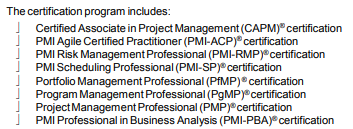
Exam Details
The PgMP exam is a lively part of the activities driving to obtaining a professional credential, thus it is important that the PgMP examination reflects exactly the practices of the program management professional. The Pgmp Test Questions are in multiple-choice format. Also, you get it 4 hours to complete the exam. The Pgmp Exam Fee for the Members is US$405.00 and Non-members are US$555.00. To maintain your PgMP, you must earn 60 professional development units (PDUs) every three years.
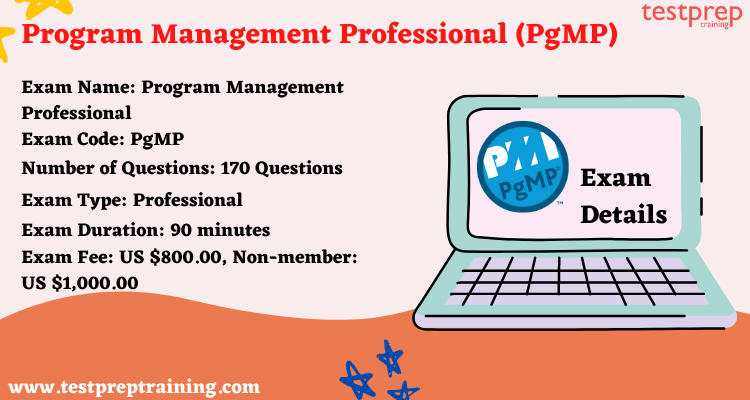
Pgmp Eligibility Requirements
- Secondary degree (high school diploma, associate’s degree or the global equivalent)
- 48 months of project management experience OR PMP
- 84 months of program management experience within the last 15 years
OR
- Four-year degree
- 48 months of project management experience OR PMP
- 48 months of program management experience within the last 15 years
Check: Program Management Professional (PgMP) Interview Questions
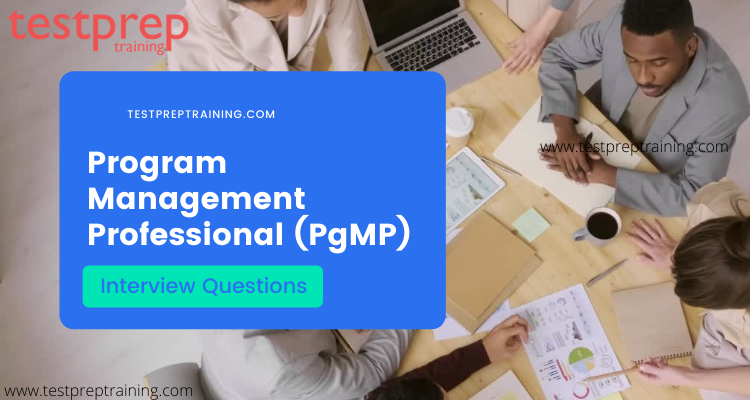
Program Management Professional (PgMP) Course Outline
Pgmp Exam Content Outline has divided the syllabus into various sections. This includes its objectives and sub-topics in it. The detailed Pgmp Course outline is mentioned below:
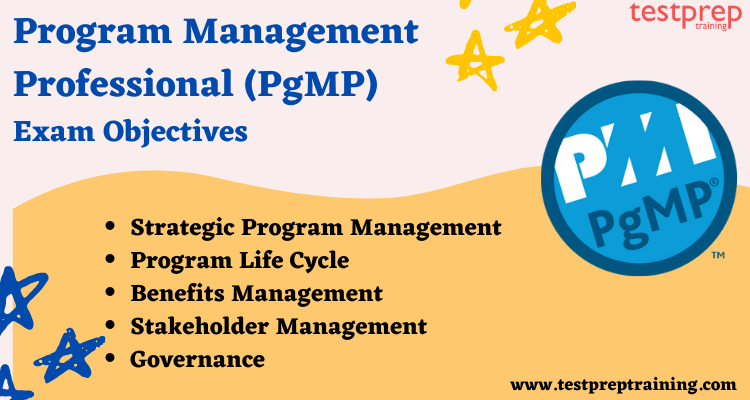
Domain I Strategic Program Management
- Perform an initial program assessment by defining the program objectives, requirements, and risks in order to ensure program alignment with the organization’s strategic plan, objectives, priorities, vision, and mission statement.
- Establish a high-level road map with milestones and preliminary estimates in order to obtain initial validation and approval from the executive sponsor.
- Define the high-level road map/framework in order to set a baseline for program definition, planning, and execution.
- Define the program mission statement by evaluating the stakeholders’ concerns and expectations in order to establish program direction.
- Evaluate the organization’s capability by consulting with organizational leaders in order to develop, validate, and assess the program objectives, priority, feasibility, readiness, and alignment to the organization’s strategic plan.
- Identify organizational benefits for the potential program using research methods such as market analysis and high-level cost-benefit analysis in order to develop the preliminary program scope and define benefits realization plan.
- Estimate the high level financial and nonfinancial benefits of the program in order to obtain/maintain funding authorization and drive prioritization of projects within the program.
- Evaluate program objectives relative to regulatory and legal constraints, social impacts, sustainability, cultural considerations, political climate, and ethical concerns in order to ensure stakeholder alignment and program deliverability.
- Obtain organizational leadership approval for the program by presenting the program charter with its high-level costs, milestone schedule and benefits in order to receive authorization to initiate the program.
- Identify and evaluate integration opportunities and needs (for example, human capital and human resource requirements and skill sets, facilities, finance, assets, processes, and systems) within program activities and operational activities in order to align and integrate benefits within or across the organization.
- Exploit strategic opportunities for change in order to maximize the realization of benefits for the organization.
Domain II Program Life Cycle
Initiating the Program:
- Develop program charter using input from all stakeholders, including sponsors, in order to initiate and design program and benefits.
- Translate strategic objectives into high-level program scope statements by negotiating with stakeholders, including sponsors, in order to create a program scope description.
- Develop a high-level milestone plan using the goals and objectives of the program, applicable historical information, and other available resources (for example, work breakdown structure (WBS), scope statements, benefits realization plan) in order to align the program with the expectations of stakeholders, including sponsors.
- Develop an accountability matrix by identifying and assigning program roles and responsibilities in order to build the core team and to differentiate between the program and project resources.
- Define standard measurement criteria for success for all constituent projects by analyzing stakeholder expectations and requirements across the constituent projects in order to monitor and control the program.
- Conduct program kick-off with key stakeholders by holding meetings in order to familiarize the organization with the program and obtain stakeholder buy-in
Planning the Program:
- Develop a detailed program scope statement by incorporating program vision and all internal and external objectives, goals, influences, and variables in order to facilitate overall planning.
- Develop program WBS in order to determine, plan, and assign the program tasks and deliverables.
- Establish the program management plan and schedule by integrating plans for constituent projects and creating plans for supporting program functions (for example, quality, risk, communication, resources) in order to effectively forecast, monitor, and identify variances during program execution.
- Optimize the program management plan by identifying, reviewing, and leveling resource requirements (for example, human resources, materials, equipment, facilities, finance) in order to gain efficiencies and maximize productivity/synergies among constituent projects.
- Define project management information system (PMIS) by selecting tools and processes to share knowledge, intellectual property, and documentation across constituent projects in order to maximize synergies and savings in accordance with the governance model.
- Identify and manage unresolved project-level issues by establishing a monitoring and escalation mechanism and selecting a course of action consistent with program constraints and objectives in order to achieve program benefits.
- Develop the transition/integration/closure plan by defining exit criteria in order to ensure all administrative, commercial, and contractual obligations are met upon program completion.
- Develop key performance indicators (KPIs) by using decomposition/ mapping/ balanced score card (BSC) in order to implement scope and quality management system within program.
- Monitor key human resources for program and project roles, including subcontractors, and identify opportunities to improve team motivation (for example, develop compensation, incentive, and career alignment plans) and negotiate contracts in order to meet and/or exceed benefits realization objectives.
Executing the Program:
- Charter and initiate constituent projects by assigning project managers and allocating appropriate resources in order to achieve program objectives.
- Establish consistency by deploying uniform standards, resources, infrastructure, tools, and processes in order to enable informed program decision making.
- Establish a communication feedback process in order to capture lessons learned and the team’s experiences throughout the program.
- Lead human resource functions by training, coaching, mentoring, and recognizing the team in order to improve team engagement and achieve commitment to the program’s goals.
- Review project managers’ performance in executing the project in accordance with the project plan in order to maximize their contribution to achieving program goals.
- Execute the appropriate program management plans (for example, quality, risk, communication, resourcing) using the tools identified in the planning phase and by auditing the results in order to ensure the program outcomes meet stakeholder expectations and standards.
- Consolidate project and program data using predefined program plan reporting tools and methods in order to monitor and control the program performance and communicate to stakeholders.
- Evaluate the program’s status in order to monitor and control the program while maintaining current program information.
- Approve closure of constituent projects upon completion of defined deliverables in order to ensure scope is compliant with the functional overview.
Controlling the Program:
- Analyze variances and trends in costs, schedule, quality, and risks by comparing actual and forecast to planned values in order to identify corrective actions or opportunities.
- Update program plans by incorporating corrective actions to ensure program resources are employed effectively in order to meet program objectives.
- Manage program level issues (for example, human resource management, financial, technology, scheduling) by identifying and selecting a course of action consistent with program scope, constraints, and objectives in order to achieve program benefits.
- Manage changes in accordance with the change management plan in order to control scope, quality, schedule, cost, contracts, risks, and rewards.
- Conduct impact assessments for program changes and recommend decisions in order to obtain approval in accordance with the governance model.
- Manage risk in accordance with the risk management plan in order to ensure benefits realization.
Closing the Program:
- Complete a program performance analysis report by comparing final values to planned values for scope, quality, cost, schedule, and resource data in order to determine program performance.
- Obtain stakeholder approval for program closure in order to initiate close-out activities.
- Execute the transition and/or close-out of all program and constituent project plans (for example, perform administrative and PMIS program closure, archive program documents and lessons learned, and transfer ongoing activities to functional organization) in order to meet program objectives and/or ongoing operational sustainability.
- Conduct the post-review meeting by presenting the program performance report in order to obtain feedback and capture lessons learned.
- Report lessons learned and best practices observed and archive to the knowledge repository in order to support future programs and organizational improvement.
Domain III Benefits Management
- Develop the benefits realization plan and its measurement criteria in order to set the baseline for the program and communicate to stakeholders, including sponsors.
- Identify and capture synergies and efficiencies identified throughout the program life cycle in order to update and communicate the benefits realization plan to stakeholders, including sponsors.
- Develop a sustainment plan that identifies the processes, measures, metrics, and tools necessary for management of benefits beyond the completion of the program in order to ensure the continued realization of intended benefits.
- Monitor the metrics (for example, by forecasting, analyzing variances, developing “what if” scenarios and simulations, and utilizing causal analysis) in order to take corrective actions in the program and maintain and/or potentially improve benefits realization.
- Verify that the close, transition, and integration of constituent projects and the program meet or exceed the benefit realization criteria in order to achieve program’s strategic objectives.
- Maintain a benefit register and record program progress in order to report the benefit to stakeholders via the communications plan.
- Analyze and update the benefits realization and sustainment plans for uncertainty, risk identification, risk mitigation, and risk opportunity in order to determine if corrective actions are necessary and communicate to stakeholders.
- Develop a transition plan to operations in order to guarantee sustainment of products and benefits delivered by the program.
Domain IV Stakeholder Management
- Identify stakeholders, including sponsors, and create the stakeholder matrix in order to document their position relative to the program.
- Perform stakeholder analysis through historical analysis, personal experience, interviews, knowledge base, review of formal agreements (for example, request for proposal (RFP), request for information (RFI), contracts), and input from other sources in order to create the stakeholder management plan.
- Negotiate the support of stakeholders, including sponsors, for the program while setting clear expectations and acceptance criteria (for example, KPIs) for the program benefits in order to achieve and maintain their alignment to the program objectives.
- Generate and maintain visibility for the program and confirm stakeholder support in order to achieve the program’s strategic objectives.
- Define and maintain communications adapted to different stakeholders, including sponsors, in order to ensure their support for the program.
- Evaluate risks identified by stakeholders, including sponsors, and incorporate them in the program risk management plan, as necessary.
- Develop and foster relationships with stakeholders, including sponsors, in order to improve communication and enhance their support for the program.
Domain V Governance
- Develop program and project management standards and structure (governance, tools, finance, and reporting) using industry best practices and organizational standards in order to drive efficiency and consistency among projects and deliver program objectives.
- Select a governance model structure including policies, procedures, and standards that conforms program practices with the organization’s governance structure in order to deliver program objectives consistent with organizational governance requirements.
- Obtain authorization(s) and approval(s) through stage gate reviews by presenting the program status to governance authorities in order to proceed to the next phase of the program.
- Evaluate key performance indicators (for example, risks, financials, compliance, quality, safety, stakeholder satisfaction) in order to monitor benefits throughout the program life cycle.
- Develop and/or utilize the program management information system), and integrate different processes as needed, in order to manage program information and communicate status to stakeholders.
- Regularly evaluate new and existing risks that impact strategic objectives in order to present an updated risk management plan to the governance board for approval.
- Establish escalation policies and procedures in order to ensure risks are handled at the appropriate level.
- Develop and/or contribute to an information repository containing program-related lessons learned, processes, and documentation contributions in order to support organizational best practices.
- Identify and apply lessons learned in order to support and influence existing and future program or organizational improvement.
- Monitor the business environment, program functionality requirements, and benefits realization in order to ensure the program remains aligned with strategic objectives.
- Develop and support the program integration management plan in order to ensure operational alignment with program strategic objectives.
Exam Policies
The candidate should go through the policies of the PMI. The terms and policies are present on the official site of the PMI. The terms and policies include the scope of the agreement, definitions, ownership, and use of PMI intellectual property, links, message boards, chat boards, blogs, virtual communities, and other interactive media, copyright compliance, and complaints, etc.
Program Management Professional (PgMP) FAQ
Program Management Professional (PgMP) Study Guide
The Pgmp Exam Preparation is not easy given the huge syllabus it covers. So, the preparation steps which are essential in order to successfully pass the exam are here in our ultimate Pgmp Program Management Professional Exam Study Guide
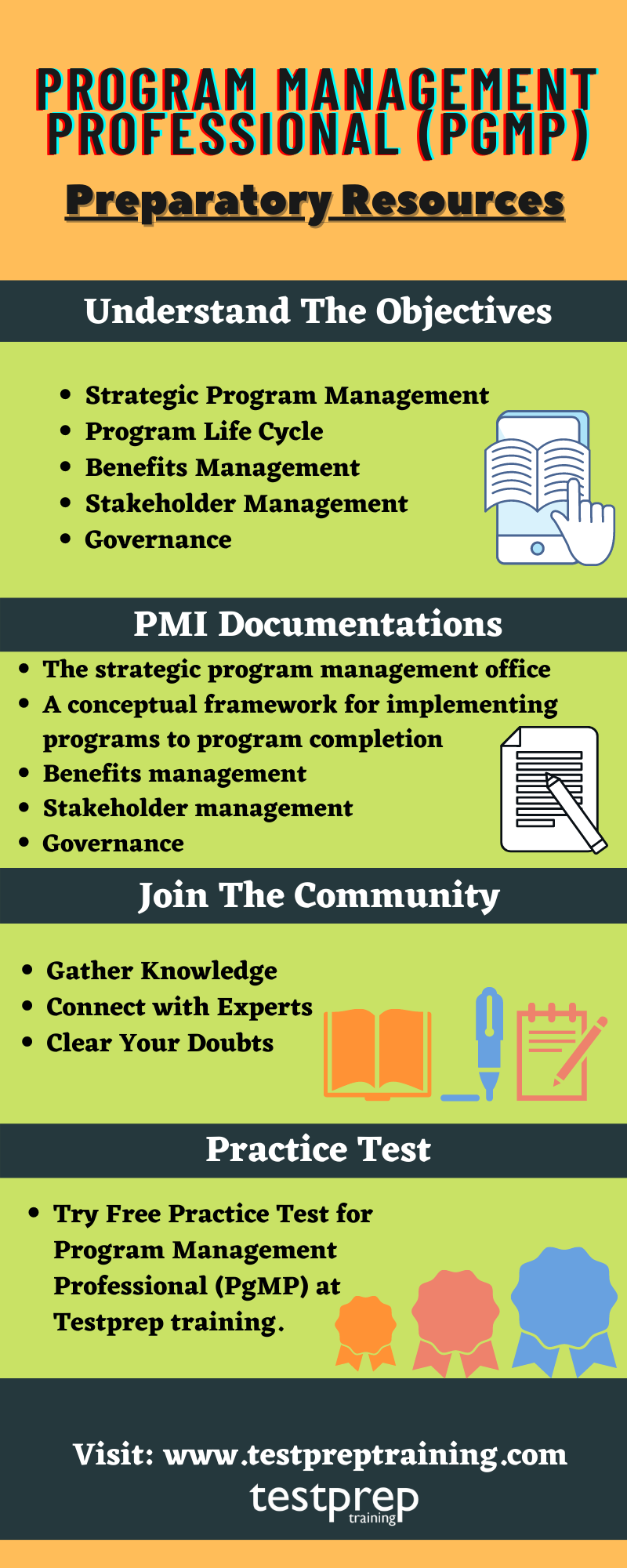
PMI Official Website
Visiting the PMI official website is a necessary step while preparing for the Program Management Professional (PgMP) exam. The official site proposes a lot of information and sources which is very important in preparing for the exam. The resources such as study guide, sample papers, whitepapers, documentation, faqs, etc. The candidate can find all such important things on the official page.
Download the Study Guide
The study guide is the next step in the preparation guide for the Program Management Professional (PgMP) exam. You will find the study guide for the Program Management Professional (PgMP) exam at the official website of the PMI. As mentioned earlier, the Exam Outline is the most important part of any certification exam. You can easily locate the exam outline in the study guide as well. Also, make sure to view if there are any important notices, you must be updated on any new changes.
PMI Training and Online Courses
The candidate can also opt for the Program Management Professional (Pgmp) Training and online courses. The PMI offers training programs on every exam. The training programs for a particular exam contain all information of the exam such as description, intended audience, delivery method, duration, etc. The candidate should join a training program to gain knowledge and skills for Program Management Professional (PgMP).
Books and Guides
The next step in the preparatory guide should be whitepapers, books, and study guides. The candidate needs to find those books which are enriched with information. Finding a good book may be a difficult task, but in order to gather knowledge and skills, the candidate has to find, read, and understand. Here, we are recommending some Pgmp Books and guides:
- PgMP: Program Management Professional Exam Study Guide 1st Edition by Paul Sanghera
- Program Management Professional (PgMP): A Certification Study Guide with Best Practices for Maximizing Business Results by Craig J. Letavec, Steven C. Rollins, Diane Altwies
- PgMP Program Management Professional All-in-One Exam Guide 1st Edition by Joseph Phillips
Join a Study Group
Joining a group study will also be helpful for the candidate. It will encourage them to do more hard work. Also, studying in the group will help them to stay connected with the other people who are on the same pathway as them. Also, the discussion of such study groups will benefit the students in their exams.
Practice Test
Practice tests are the one which guarantees the candidate about their preparation. The Pgmp Practice Test will assist the candidates to acknowledge their weak areas so that they can work on them. There are many practice tests available on the internet nowadays, so the candidate can choose which they want.


